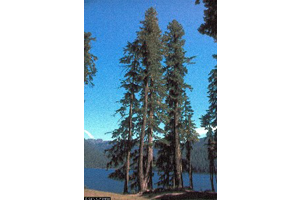Douglas-fir is the second-tallest conifer in the world (after the coast redwood); it commonly lives more than 500 years and occasionally more than 1,000 years.
Photo Credit: © Gary A. Monroe, USDA-NRCS PLANTS Database.
Pseudotsuga menziesii
Common Name: Douglas-fir
Other Common Names: Douglas fir, Douglas spruce, Oregon pine, red fir
Plant Functional Group: Evergreen conifer
Class > Order > Family: Pinopsida > Pinales > Pinaceae
What does the species look like?
Douglas-fir is an evergreen, coniferous tree growing 40 to 250 feet tall or more, with height varying across regions. Male and female cones are present on the same tree. Trees begin producing cones at about 12 to 15 years of age. The small, reddish-brown or yellow male cones bear pollen; the larger female cones start out green and, when mature, develop papery scales. Pollination occurs by wind.
Douglas-fir can be found from sea level up to 10,000 feet, in a wide range of climates. Although it is adapted to a moist, mild climate, and grows on a wide variety of soils, it does best on well-aerated, deep soils. Its distribution is limited by temperature in the northern extent of its range and moisture in the southern extent of its range.
Where is the species found?
States & Provinces
AB, AZ, BC, CA, CO, ID, MN, MT, NM, NV, OR, PA, TX, UT, WA, WY
Which phenophases should I observe?
Do you see...?
Needles
Breaking needle buds More...
How many buds are breaking?
Less than 3 3 to 10 11 to 100 101 to 1,000 1,001 to 10,000 More than 10,000
Young needles How many young needles are present?
Less than 3 3 to 10 11 to 100 101 to 1,000 1,001 to 10,000 More than 10,000
Pollen cones
Pollen cones More...
How many fresh pollen cones are present?
Less than 3 3 to 10 11 to 100 101 to 1,000 1,001 to 10,000 More than 10,000
Open pollen cones What percentage of all fresh pollen cones (unopened plus open) on the plant are open?
Less than 5% 5-24% 25-49% 50-74% 75-94% 95% or more
Pollen release More...
How much pollen is released?
Little: Only a few grains are released. Some: Many grains are released. Lots: A layer of pollen covers your palm, or a cloud of pollen can be seen in the air when the wind blows
Seed cones
Unripe seed cones Pseudotsuga menziesii , an unripe seed cone is green or brown with scales closed together.More...
How many seed cones are unripe?
Less than 3 3 to 10 11 to 100 101 to 1,000 1,001 to 10,000 More than 10,000
Ripe seed cones Pseudotsuga menziesii , a seed cone is considered ripe when it has turned brown and the scales have begun to spread apart to expose the seeds inside. Do not include empty cones that have already dropped all of their seeds.More...
How many seed cones are ripe?
Less than 3 3 to 10 11 to 100 101 to 1,000 1,001 to 10,000 More than 10,000
Recent cone or seed drop More...
How many seed cones have dropped seeds or have completely dropped or been removed from the plant since your last visit?
Less than 3 3 to 10 11 to 100 101 to 1,000 1,001 to 10,000 More than 10,000
What do these phenophases look like?
There is currently no photoguide available for this species. If you'd like help us create one, use the guidance document and species template provided here . Then send it via email to education@usanpn.org when it is complete.
